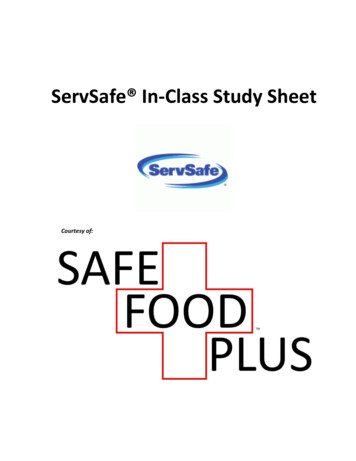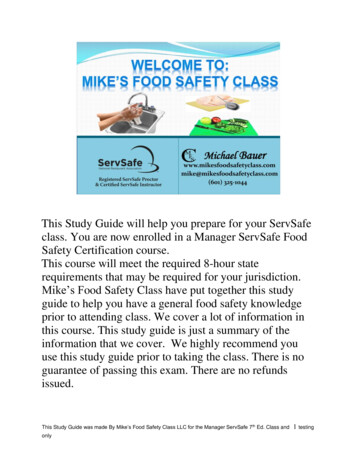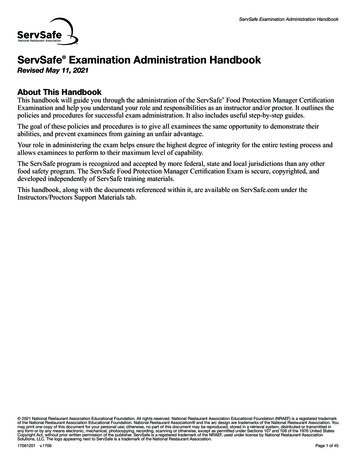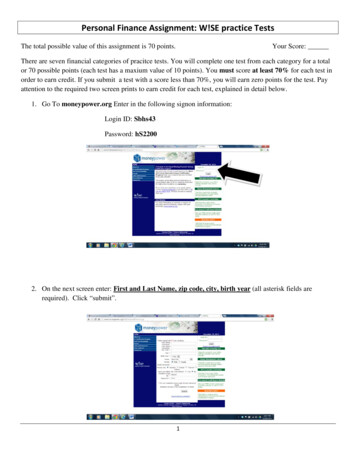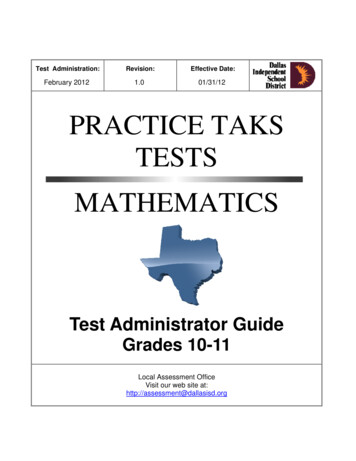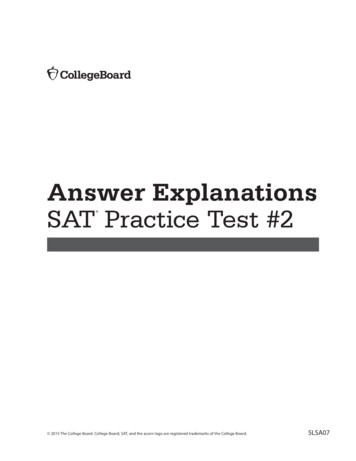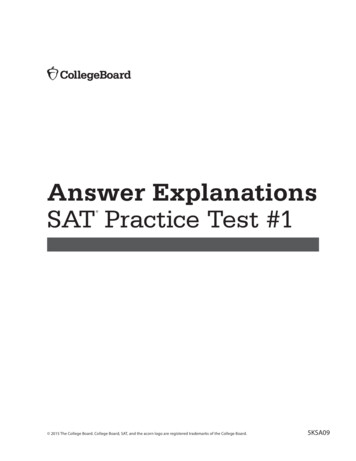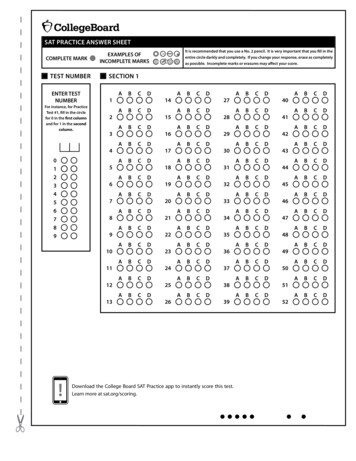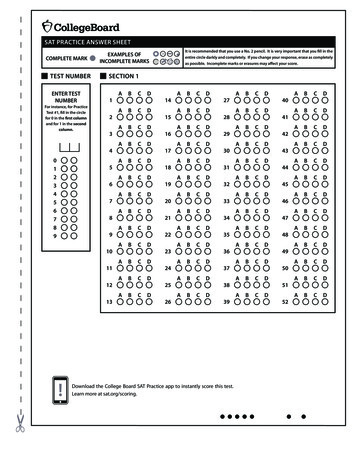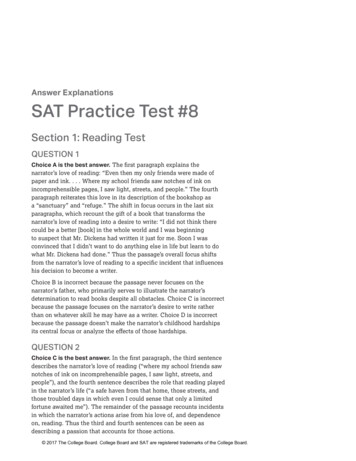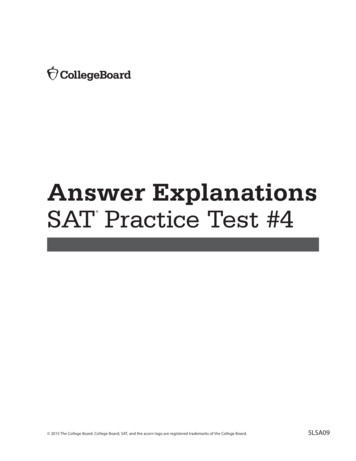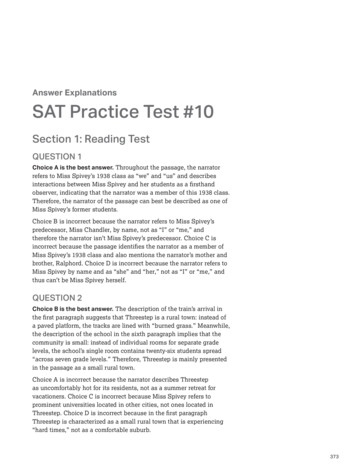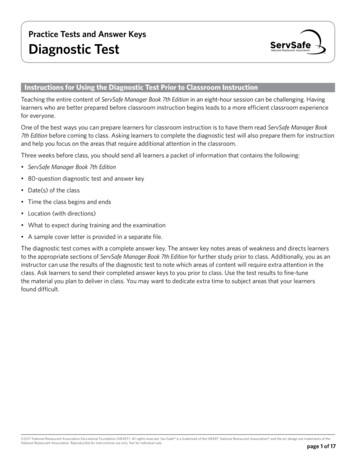
Transcription
Practice Tests and Answer KeysDiagnostic TestInstructions for Using the Diagnostic Test Prior to Classroom InstructionTeaching the entire content of ServSafe Manager Book 7th Edition in an eight-hour session can be challenging. Havinglearners who are better prepared before classroom instruction begins leads to a more efficient classroom experiencefor everyone.One of the best ways you can prepare learners for classroom instruction is to have them read ServSafe Manager Book7th Edition before coming to class. Asking learners to complete the diagnostic test will also prepare them for instructionand help you focus on the areas that require additional attention in the classroom.Three weeks before class, you should send all learners a packet of information that contains the following: ServSafe Manager Book 7th Edition 80-question diagnostic test and answer key Date(s) of the class Time the class begins and ends Location (with directions) What to expect during training and the examination A sample cover letter is provided in a separate file.The diagnostic test comes with a complete answer key. The answer key notes areas of weakness and directs learnersto the appropriate sections of ServSafe Manager Book 7th Edition for further study prior to class. Additionally, you as aninstructor can use the results of the diagnostic test to note which areas of content will require extra attention in theclass. Ask learners to send their completed answer keys to you prior to class. Use the test results to fine-tunethe material you plan to deliver in class. You may want to dedicate extra time to subject areas that your learnersfound difficult. 2017 National Restaurant Association Educational Foundation (NRAEF). All rights reserved. ServSafe is a trademark of the NRAEF. National Restaurant Association and the arc design are trademarks of theNational Restaurant Association. Reproducible for instructional use only. Not for individual sale.page 1 of 17
Practice Tests and Answer KeysDiagnostic TestNameDateCircle the best answer to each question below. Be sure to answer all 80 questions.1 The purpose of a food safety management system is toABCDkeep all areas of the facility clean and pest-free.identify, tag, and repair faulty equipment within the facility.prevent foodborne illness by controlling risks and hazards.use the correct methods for purchasing and receiving food.2 A manager’s responsibility to actively control risk factors for foodborne illnesses is calledABCDhazard analysis critical control point (HACCP).quality control and assurance.food safety management.active managerial control.3 A manager asks a chef to continue cooking chicken breasts after seeing them cooked to an incorrect temperature.This is an example of which step in active managerial control?ABCDIdentifying risksMonitoringCorrective actionRe-evaluation4 A manager walks around the kitchen every hour to answer questions and to see if staff members are following procedures.This is an example of which step in active managerial control?ABCDManagement oversightCorrective actionRe-evaluationIdentify risks5 One way for managers to show that they know how to keep food safe is toABCDbecome certified in food safety.take cooking temperatures.monitor employee behaviors.conduct self-inspections.6 A power outage has left hot TCS food out of temperature control for six hours. What must be done with the food?ABCDCool the food to 41 F (5 C) or lower.Serve the food immediately.Cook the food 165 F (74 C).Throw the food away. 2017 National Restaurant Association Educational Foundation (NRAEF). All rights reserved. ServSafe is a trademark of the NRAEF. National Restaurant Association and the arc design are trademarks of theNational Restaurant Association. Reproducible for instructional use only. Not for individual sale.page 2 of 17
Practice Tests and Answer Keys Diagnostic Test7 An imminent health hazard, such as a water supply interruption, requires immediate correction orABCDa HACCP plan.closure of the operation.evaluation of the situation.normal operating procedures.8 What is the best way to protect food from deliberate tampering?ABCDMake it as difficult as possible for someone to tamper with it.Allow former employees into the operation.Perform spot inspections on new vendors.Use the USDA A.L.A.R.M. system.9 To prevent the deliberate contamination of food, a manager should know whom to contact about suspicious activity,monitor the security of products, keep information related to food security on file, and knowABCDwhen to register with the EPA.how to fill out an incident report.where to find Safety Data Sheets in the operation.who is in the facility.!0 Where should food handlers wash their hands?ABCDPrep sinkUtility sinkDesignated sink for handwashingThree-compartment sink!1 What must food handlers do after touching their body or clothing?ABCDWash their handsRinse their glovesChange their apronsUse a hand antiseptic!2 When washing hands, what is the minimum time that food handlers should scrub hands and arms with soap?ABCD5 seconds8 seconds10 seconds18 seconds!3 After which activity must food handlers wash their hands?ABCDClearing tablesPutting on glovesServing customersApplying hand antiseptic 2017 National Restaurant Association Educational Foundation (NRAEF). All rights reserved. ServSafe is a trademark of the NRAEF. National Restaurant Association and the arc design are trademarks of theNational Restaurant Association. Reproducible for instructional use only. Not for individual sale.page 3 of 17
Practice Tests and Answer Keys Diagnostic Test!4 What is the main reason for food handlers to avoid scratching their scalps?ABCDTransferring a food allergenSpreading pathogens to the foodGetting food in their hairCausing toxic-metal poisoning!5 When may food handlers wear plain-band rings?ABCDAt any timeWhen not handling foodOnly if wearing glovesOnly if washing dishes!6 What should a food handler do when working with an infected cut on the finger?ABCDCover the wound with a bandage.Stay away from food and prep areas.Cover the hand with a glove or a finger cot.Cover the wound with an impermeable bandage or finger cot and a glove.!7 What is the only jewelry that may be worn on the hands or arms while handling food?ABCDPlain-band ringMedical ID braceletLeather-band watchDiamond ring!8 In addition to other criteria, how many people must have the same symptoms in order for a foodborne illness to beconsidered an outbreak?ABCDAt least 1At least 2At least 10At least 20!9 When should a food handler with a sore throat and fever be excluded from the operation?ABCDCustomers served are primarily a high-risk populationFever is over 100 F (38 C)Sore throat has lasted for more than 5 daysBefore the regulatory authority is notified@0 What is a basic characteristic of a virus?ABCDDestroyed by cookingGrows in foodRequires a living host to growCommonly found in cattle intestines 2017 National Restaurant Association Educational Foundation (NRAEF). All rights reserved. ServSafe is a trademark of the NRAEF. National Restaurant Association and the arc design are trademarks of theNational Restaurant Association. Reproducible for instructional use only. Not for individual sale.page 4 of 17
Practice Tests and Answer Keys Diagnostic Test@1 After handling raw meat and before handling produce, what should food handlers do with their gloves?ABCDClean and sanitize them.Continue working with them.Set them aside if working with meat again later.Wash hands and change them.@2 Where should personal items, like a coat, be stored in the operation?ABCDOn a shelf, above foodOn a shelf, below foodIn a designated area, away from foodIn a kitchen, away from moving equipment@3 What should food handlers do after prepping food and before using the restroom?ABCDWash their handsTake off their hatsChange their glovesTake off their aprons@4 How should the temperature of a shipment of sour cream be taken when it arrives at an operation?ABCDPlace a hand on a container to see if it is cool to the touch.Hold an infrared thermometer as close as possible to a case.Place the thermometer stem between shipping boxes for a reading.Remove the lid of a container and put the thermometer stem into the sour cream.@5 Ice crystals on a frozen food item indicateABCDtime-temperature abuse.cross-contamination.poor cleaning and sanitizing.poor personal hygiene.@6 What is the most important factor in choosing an approved food supplier?ABCDIt has a HACCP program or other food safety system.It has documented manufacturing and packing practices.Its warehouse is close to the operation, reducing shipping time.It has been inspected and complies with local, state, and federal laws.@7 Which item should be rejected?ABCDBags of organic cookies in torn packagingBottled milk at 41 F (5 C)Single-use cups in original packingLive oysters with an internal temperature of 50 F (10 C) 2017 National Restaurant Association Educational Foundation (NRAEF). All rights reserved. ServSafe is a trademark of the NRAEF. National Restaurant Association and the arc design are trademarks of theNational Restaurant Association. Reproducible for instructional use only. Not for individual sale.page 5 of 17
Practice Tests and Answer Keys Diagnostic Test@8 Supplies should be stored away from the walls and at leastABCDoff of the floor.2 inches (5 centimeters)4 inches (10 centimeters)5 inches (13 centimeters)6 inches (15 centimeters)@9 Soup on a buffet should be labeled with theABCDname of the food.prep date.soup’s ingredients.use-by date.#0 How should chemicals be stored?ABCDAbove foodAway from prep areasIn food storage areasWith kitchenware#1 What should be done to ready-to-eat TCS food that will be prepped on-site and held for longer than 24 hours?ABCDDate mark it.Sell it.Throw it away.Serve it within the next hour.#2 What must a manager do with a recalled food item in the operation?ABCDCombine the item with non-recalled items during preparation.Record the names of customers who purchase the item.Store the recalled item separately from other food.Sell all recalled items within 24 hours.#3 A recall has been issued for a specific brand of orange juice. The store manager has matched the information from the recallnotice to the item, removed the item from inventory, and stored it in a secure location. What should the manager do next?ABCDRefer to the vendor notification for next steps.Contact the supplier and arrange for the product to be picked up.Label the item to prevent it from accidently being placed back in inventory.Inform the local media, customers, and employees of the reason for the recall.#4 A food item that is received with an expired use-by date should beABCDrejected.used immediately.accepted but labeled differently.accepted but kept separate from other items. 2017 National Restaurant Association Educational Foundation (NRAEF). All rights reserved. ServSafe is a trademark of the NRAEF. National Restaurant Association and the arc design are trademarks of theNational Restaurant Association. Reproducible for instructional use only. Not for individual sale.page 6 of 17
Practice Tests and Answer Keys Diagnostic Test#5 Cold food can be held intentionally without temperature control forABCDhours as long as it does not exceed 70 F (21 C).2468#6 When delivering food for off-site service, raw poultry must be storedABCDat a lower temperature than ready-to-eat food.separately from ready-to-eat food.without temperature control.above raw beef.#7 What is the minimum internal cooking temperature for seafood?ABCD135 F (57 C) or higher for 15 seconds145 F (63 C) or higher for 15 seconds155 F (68 C) or higher for 15 seconds165 F (74 C) or higher for 15 seconds#8 Food must be cooled from 135 F (57 C) toABCDwithin 2 hours.80 F (27 C)45 F (7 C)70 F (21 C)41 F (5 C)#9 Hot TCS food being hot-held for service must be at what temperature?ABCD70 F (21 C) or above125 F (52 C) or above135 F (57 C) or above155 F (68 C) or above 0 Which method is a safe way to thaw food?ABCDAs part of the cooking processUnder running water at 125 F (52 C) or higherSubmerged in a sink of standing water at 70 F (21 C)On the counter at room temperature 1 Food being cooled must pass quickly through which temperature range to reduce pathogen growth?ABCD65 F to 20 F (18 C to -6 C)125 F to 70 F (52 C to 21 C)180 F to 130 F (82 C to 54 C)220 F to 195 F (104 C to 90 C) 2017 National Restaurant Association Educational Foundation (NRAEF). All rights reserved. ServSafe is a trademark of the NRAEF. National Restaurant Association and the arc design are trademarks of theNational Restaurant Association. Reproducible for instructional use only. Not for individual sale.page 7 of 17
Practice Tests and Answer Keys Diagnostic Test 2 What food item does the FDA advise against offering on a children’s menu?ABCDRare cheeseburgersCheese pizzaPeanut butter and jelly sandwichesFried shrimp 3 A food handler with a sore throat and a fever should be excluded from working in a day-care center, because the childrenABCDwill not receive the same level of service.could make the food handler more sick.are a high-risk population.will refuse to eat. 4 Which is a chemical contaminant?ABCDBones in a chicken filletNorovirus in shellfishMetal shavings in a can of peachesTomato juice served in a pewter pitcher 5 Which is a biological contaminant?ABCDBones in a chicken filletNorovirus in shellfishMetal shavings in a can of peachesTomato juice served in a pewter pitcher 6 The 6 conditions bacteria need to grow are food, acidity, temperature, time, oxygen, andABCDmeat.moisture.melatonin.management. 7 Using the same knife to chop carrots for a salad immediately after cutting up raw chicken is an example ofABCDtime-temperature abuse.cross-contamination.poor personal hygiene.purchasing from an unapproved supplier. 8 Which is an example of physical contamination?ABCDSneezing on foodTouching dirty food-contact surfacesBones in fishCooking tomato sauce in
ServSafe Manager Book 7th Edition 80-question diagnostic test and answer key Date(s) of the class Time the class begins and ends Location (with directions) What to expect during training and the examination A sample cover letter is provided in a separate file. The diagnostic test comes with a complete answer key. The answer key notes areas of weakness and directs .File Size: 221KBPage Count: 17
